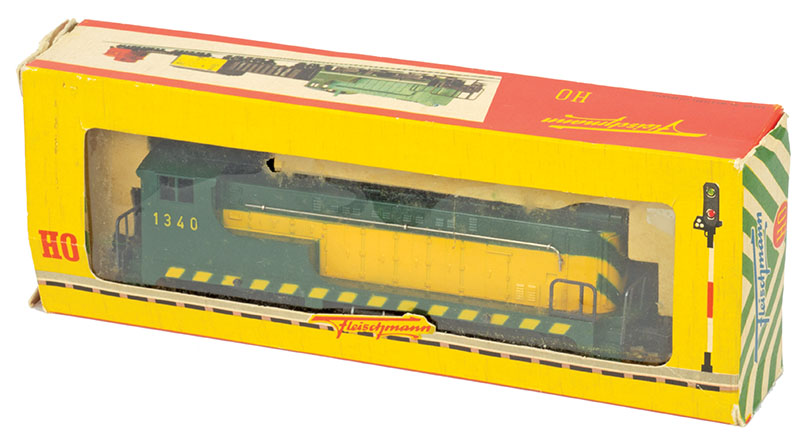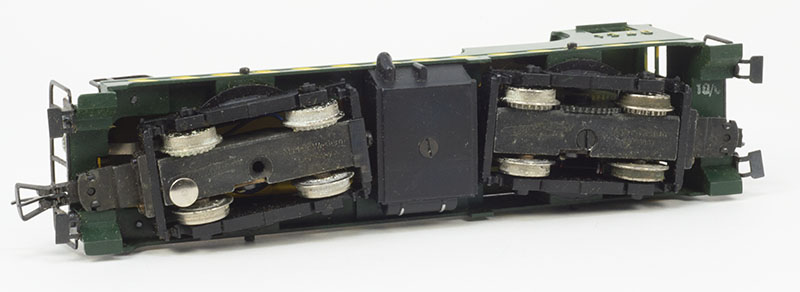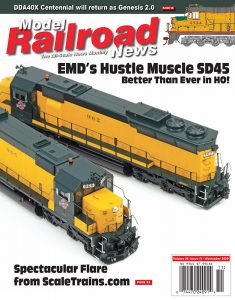Chicago & North Western (C&NW) enjoys a large following. For example, Chicago & North Western Historical Society (cnwhs.org) membership is among the largest of any organization devoted to railroad preservation and history. Today, you’ll find C&NW releases included frequently by hobby manufacturers, as demonstrated by the excellent group of reviews in November 2020’s Model Railroad News.
What was the situation for C&NW enthusiasts working in HO during the scale’s expansion years in the 1950s? Looking over offerings in HO scale in the post-World War II years, yellow and green motive power was much less common than it is today. Among the onslaught of plastic cab units that populated mid-20th century HO diesels, I think you’ll be surprised by the lack of C&NW.
What might have been the first HO-scale diesel locomotive model to come dressed from the factory in C&NW colors wasn’t an Athearn or Varney F-unit. I’d give credit to West Germany’s Fleischmann line and its Baldwin diesel switcher decorated for Chicago & North Western.

Above: Unlettered, but unmistakably Chicago & North Western, this is one of two Fleischmann releases decorated in yellow and green. The 1340 on the cab, highlighted in yellow paint on this example, is made of raised numerals cast as part of the die-cast metal shell.
In the early 1950s, Fleischmann introduced several freight car models of North American prototype design and produced a 4-6-2 Pacific with a passable appearance that suggested a U.S. style steam locomotive. By mid-1955, the company was touting several HO units on the way with a “Baldwin-Westinghouse Diesel” among the promised future releases. The die-cast metal switcher made it to hobby shops in time for holiday gift giving in 1955. Fleischmann promoted this model with ad copy stating, “Practically every prototype road uses many of these sturdy engines for all kinds of work.” Baldwin’s end-cab VO-series switchers, which this metal replica generally reproduces, did sell to a great many railroads both large and small. You could find them at work on Class 1s like Pennsylvania Railroad, Santa Fe, and Union Pacific, and on down to short lines and industrial roads such as Litchfield & Madison and Phelps Dodge. C&NW was no exception; the road rostered 10 examples of Baldwin’s VO-660 and a dozen VO-1000s and would pick up that mentioned short line Litchfield & Madison unit. As was the situation with many early diesel builders that were not Electro-Motive Division or even Alco, Baldwin’s switchers were minority units on most roads and didn’t have career longevity matching SW1s or RS-3s.

Above: Here’s a look at the underside of this 1950s Fleischmann switcher.
Until Athearn’s 1970s Baldwin S-12 release, this Fleischmann effort may have had this sector of the diesel model market to itself. The assembled switcher carried a $14.95 suggested retail in 1955. All known models share the same metal shell featuring a raised “1340” road number on the cab sides. The air horn and hood railings were separate and made of metal, as was the pair of handrails on the sides of the rear cab door. Other railings were stamped metal. The model came in at least a couple generic color combinations, and Chicago & North Western’s yellow and green livery. You’ll find this yellow and green switcher with and without C&NW herald and slogan decoration. The model appears to remain in Fleischmann’s catalog into the mid- to late 1960s. This is an interesting piece of HO history and might well be the first time modelers could walk into a hobby shop and purchase a Chicago & North Western-decorated locomotive.




